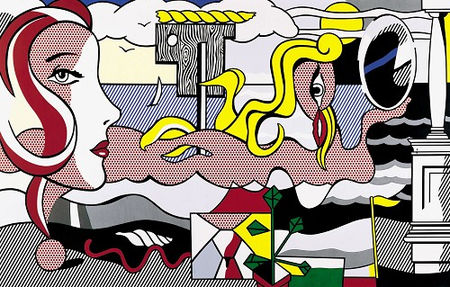"Roy Lichtenstein. Kunst als Motiv" @ Museum Ludwig
Roy Lichtenstein, Figures in Landscape, 1977, Louisiana Museum of Modern Art, Humlebaek, Denmark, © VG Bild-Kunst Bonn, 2010
COLOGNE.- The halftone dots used by Pop maestro Roy Lichtenstein (1923-1997) are world famous. Taking motifs from the realms of comics and consumerism, Lichtenstein made paintings by piecing together dots and coloured surfaces. But a very different side of his work can be discovered at this exhibition in Museum Ludwig. Around 100 exhibits, chiefly large-scale paintings along with a number of sculptures and drawings, reveal his fascinating explorations of style through the history of art – from Expressionism and Futurism to Bauhaus and Art Deco. Lichtenstein even appropriated works by his artist heroes - Picasso, Matisse, Mondrian and even Dali - and interpreted them in an often ironic and cryptic manner using his own visual language.
Many of his early works are based on historic American paintings, such as by Benjamin West. But he also painted after such models as Picasso, Braque and Klee, who according to his own words he worked into an “expressionist Cubism”.
Indeed, Lichtenstein even continued his takes on Picasso later on, once he had already begun to work with the half-tone dots. In his hands, Picasso’s works became a kind of comic and received a character all of its own. Painting a work that clearly resembled Picasso was, according to Lichtenstein, a liberating act.
With his Perfect and Imperfect Paintings Lichtenstein wanted to create abstract works purely for their own sake. According to him, the idea was to let the line start at some point and then to follow it, thus allowing it to draw all of the shapes in the painting. In his “Perfect Paintings” the line ended at the edge of the canvas, while in the “Imperfect Paintings” the line went beyond the bounds of the canvas; this was in fact a humorous play on the idea of the “shaped canvases”, which were very popular in the 1960s.
Lichtenstein’s large-scale paintings from the series “Brushstrokes” show nothing more than gigantic, stylised, comic-like brushstrokes on canvas. This motif has great significance in the history of art: it is a symbol of painting or indeed art per se, and testifies to Lichtenstein’s reflections on paintings about painting.
Lichtenstein also reworked classic motifs, such as the Laokoon group using stylised brushstrokes, which he sometimes applied to the canvas with stencils and sometimes by hand using expressive gestures. The brush stoke became the dominant motif and superimposed itself on the subject. So once again, his actual theme was painting as such.
Apart from this, Lichtenstein also turned his mind to the classic genres of the still life and the landscape. His strongly simplifying style of painting allowed him to capture his subjects in a kind of cliché. Here again he continued to reference Picasso, as well as Matisse. And he also cited his fellow countrymen who specialised in marine still lifes. For his landscapes he took the background of comic drawings as his basis.
Museum Ludwig has the largest collection of American Pop Art outside of the USA, including numerous works by Lichtenstein. Prior to the exhibition, the Peter and Irene Ludwig Foundation has managed to acquire another large-scale work from Lichtenstein’s late period. The 2.80 x 1.30 m canvas from 1996 comes from a series of works inspired by Asiatic motifs. During the mid-nineties Roy Lichtenstein took a long look at Chinese and Japanese landscape painting.
After completing the Lichtenstein exhibition it is worth taking a tour round the permanent collection at Museum Ludwig, which presents fascinating cross-connections and comparisons with works by Léger and Picasso and even Kirchner and Dalí.
The exhibition was organised in close co-operation with the Roy Lichtenstein Foundation. It was shown from January till May in a different form in Milan’s “Triennale di Milano” under the title “Roy Lichtenstein: Meditations on Art”. It was curated by Gianni Mercurio, who has worked with Stephan Diederich for the exhibition at Museum Ludwig.
A documentary film on Roy Lichtenstein will also be shown at the exhibition containing hitherto unreleased material from international archives, as well as excerpts from Michael Blackwood’s film Roy Lichtenstein from 1976 and passages from interviews with Diane Waldman and Martin Friedman.
Roy Lichtenstein, Girl with tear I, 1977, Guggenheim Museum New York, © VG Bild-Kunst Bonn, 2010 Roy Lichtenstein, Laocoon, 1988, © VG Bild-Kunst Bonn, 2010 Roy Lichtenstein, Still Life with Net, Shell, Rope and Pulley, 1972, Museum Ludwig, Köln, © VG Bild-Kunst Bonn, 2010 Roy Lichtenstein, Frolic, 1977, © VG Bild-Kunst Bonn, 2010 Roy Lichtenstein, Tall Mountains, 1996, Museum Ludwig, Köln, © VG Bild-Kunst Bonn, 2010 Roy Lichtenstein, Die Kathedralen von Rouen (Zu drei verschiedenen Tageszeiten gesehen, Folge 2, 1977, Museum Ludwig, Köln, © VG Bild-Kunst Bonn, 2010

/https%3A%2F%2Fprofilepics.canalblog.com%2Fprofilepics%2F1%2F0%2F100183.jpg)
/https%3A%2F%2Fstorage.canalblog.com%2F03%2F02%2F119589%2F96711876_o.jpg)
/https%3A%2F%2Fstorage.canalblog.com%2F11%2F31%2F119589%2F94773502_o.jpg)
/https%3A%2F%2Fstorage.canalblog.com%2F20%2F83%2F119589%2F94772815_o.jpg)
/https%3A%2F%2Fstorage.canalblog.com%2F26%2F72%2F119589%2F75604929_o.jpg)
/https%3A%2F%2Fstorage.canalblog.com%2F59%2F60%2F119589%2F26458628_o.jpg)









/http%3A%2F%2Fstorage.canalblog.com%2F95%2F36%2F119589%2F127146553_o.jpg)
/http%3A%2F%2Fstorage.canalblog.com%2F47%2F97%2F119589%2F126822262_o.jpg)
/http%3A%2F%2Fstorage.canalblog.com%2F11%2F87%2F119589%2F120945853_o.jpg)
/http%3A%2F%2Fstorage.canalblog.com%2F98%2F10%2F119589%2F120397015_o.jpg)